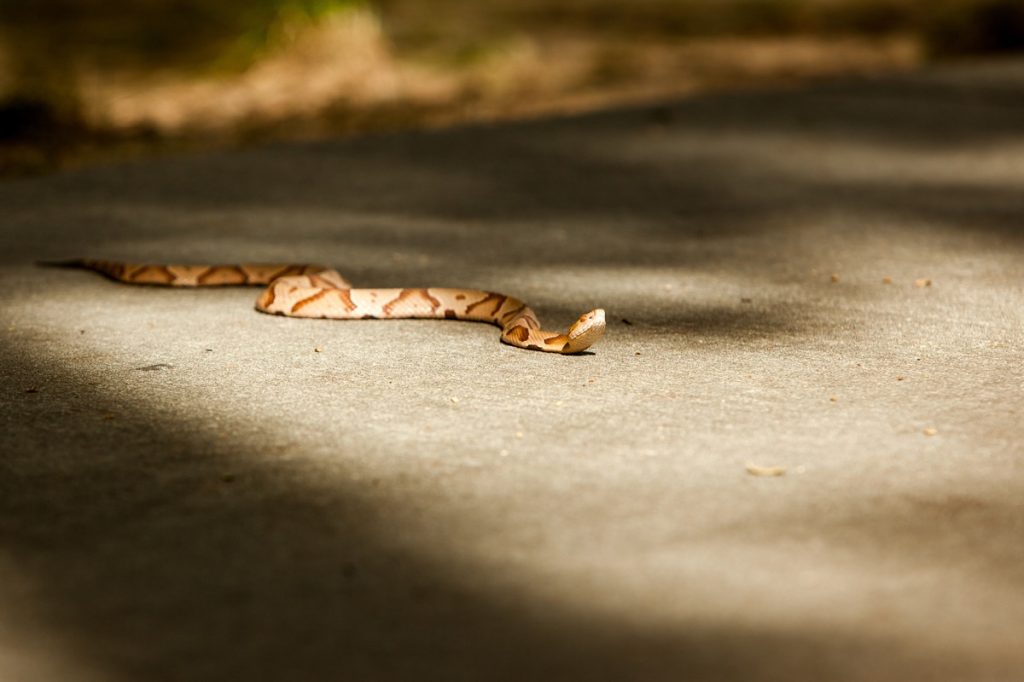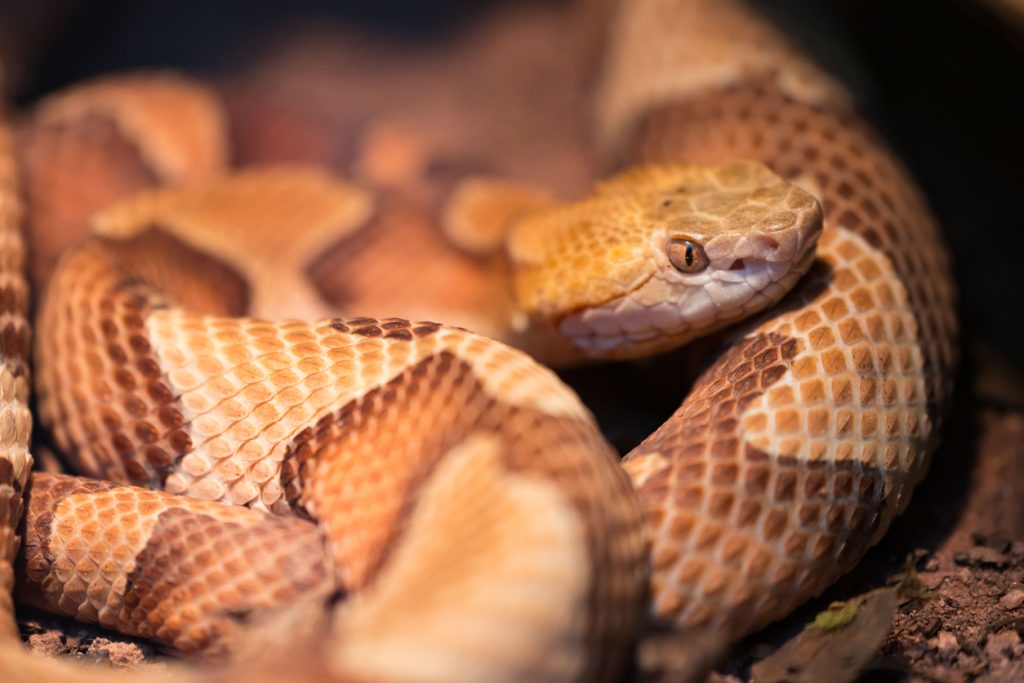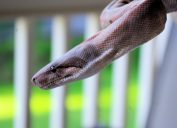Copperhead Bites Woman Outside Home: New Precautions You Need to Follow
The victim was hospitalized after the venomous reptile bit her on both feet.

Depending on where you live, the risk of running into a copperhead snake on your property might just be something you have to stay aware of whenever you're outside. Unfortunately, even those who try their best to steer clear of them can still be taken by surprise. And even though they're not naturally aggressive, surprise encounters with the venomous reptiles can lead to serious injury and hospitalization. Now, officials have begun to urge new precautions after a copperhead bit a woman outside her home at night. Read on for more information and how you can keep yourself safe.
READ THIS NEXT: Giraffe-Sized Python Found in the U.S.—Why They're Unstoppable.
A woman was bitten by a copperhead snake in New Jersey outside her home.

The warm summer weather makes it easy to slip outdoors in the evenings without as much as a second thought. But on the evening of July 21, a New Jersey woman was bitten by a copperhead snake while taking out her friend's dog around midnight, Patch reports.
The unnamed victim said she slid into a pair of flip-flops and made her way toward her paved driveway while the dog made its way around the yard. But under pitch-black conditions, she didn't notice a copperhead resting on the asphalt until it was too late.
"It got me in both feet," she told Patch. "The bite was so painful. It felt like being struck by lightning twice. It was the worst pain you can imagine."
RELATED: 17-Year-Old Bitten by Rattlesnake in His Home—Where It Was Hiding.
The injury landed the woman in a hospital for four days.

The victim says she wasn't able to get a good look at the snake before it slithered away into the darkness. But she realized as soon as she made her way back indoors that her injury was severe, telling Patch that it "felt like both feet were standing on hot coals. They were burning, and I couldn't walk on them."
Fortunately, the woman's children acted quickly and decided to drive her to a nearby hospital for medical attention, where she was held for treatment for four days before returning home.
"They saved my life, which I am grateful for. If I hadn't been treated, I wouldn't have made it through," said told Patch.
Even after leaving the hospital, the woman said she struggled to walk for days before eventually readmitting herself for severe swelling in her legs. And while she's chosen to remain anonymous, she decided to speak up about the incident because she "just wants people to be aware and really safe. If a pet or child was bitten, it would be bad," she told Patch.
RELATED: 8 Things in Your Yard That Are Attracting Snakes to Your Home.
Local officials are warning that residents should take new precautions, even though the snakes are rare in the area.

The victim says she reported the incident to local authorities at the Fish and Wildlife Division of the New Jersey Department of Environmental Protection (NJDEP) on July 27, according to NJ.com. But while a search of her property didn't turn up any copperheads, officials are still warning locals to be more cautious when outdoors.
"Residents living in areas where venomous snakes occur are advised to wear closed-toed shoes and use a flashlight when outdoors after dark," NJDEP wrote in a statement.
Officials point out that while the area is technically home to copperheads, they are still an "uncommon" sight. But besides protecting your feet and remaining alert, it's essential to remember that the venomous species isn't aggressive by nature, meaning it's best to keep your distance from any snakes you might spot.
"No one has ever died from a copperhead bite in [New Jersey]," NJDEP writes. "These snakes will not chase you, but they will defend themselves if they feel threatened."
RELATED: For more up-to-date information, sign up for our daily newsletter.
Here's how you can protect yourself from snakes—and what to do if you're ever bitten.

It might be comforting to know that officials say the latest copperhead bite incident is exceedingly rare in the area. But experts caution that the loss of habitat due to home construction and climate change could be making such incidents slightly more common. This includes a study published on July 11 in the journal GeoHealth, which found that the risk of being bitten by a venomous snake increases nearly six percent for every one degree Celsius the temperature rises.
Exercising caution can help you avoid getting bitten in the first place. According to NJDEP, copperheads are most active between May and October and will use their camouflage to hide in places like leaf piles and potted plants. If you notice a snake on your property, it's best to leave it alone and call a professional to remove it if it doesn't appear to be leaving on its own.
If you do end up getting bitten, it's best to seek out medical attention immediately. "You do have time to get to the hospital," Steve Lengen, a reptile expert known as NJ Snake Man, told Bronx News 12. "It's most likely not going to be life-threatening. If you do [get bit], get the proper care. You will know right away that you have been bitten by something venomous because it's going to hurt a lot."
According to the Centers for Disease Control and Prevention (CDC), it's also helpful to get a photo of the snake in question to help doctors determine treatment—but only if you can do it safely. You should also wash the bite area with soap and water and remove any restrictive jewelry or clothing that could be affected by swelling. However, avoid taking any painkillers preemptively, and never ice the wound, slash the bite marks, or try to suck out the venom.





















